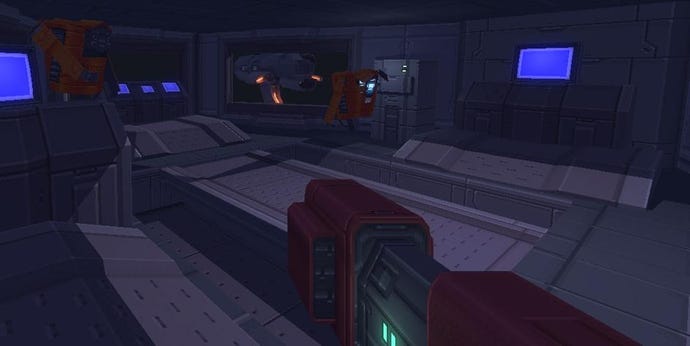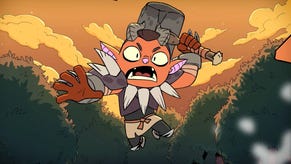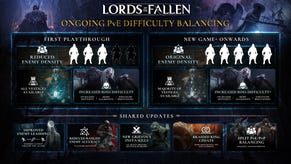Behind the scenes at Mojang: the birth and abrupt end to Minecraft follow-up 0x10c
In this exclusive excerpt from his book A Year With Minecraft: Behind the Scenes at Mojang, Thomas Arnoth details the beginning and abrupt end to Notch's "difficult second album."
Look, I made a mistake
There is another universe parallel to ours, one where the space race never ended. In fact, space exploration once was so accessible that it became popular with wealthy companies and individuals. But in 1988, something went horribly wrong. A new type of cell for deep sleep was released, a cell compatible with every 16-bit computer.
Unfortunately, there was a design flaw with the computers controlling the sleeping cells, a flaw that made everyone in the cells sleep until the year 281 474 976 712 644. When people then slowly started waking up, they awoke to a universe on the brink of extinction, a universe where the black holes were many and energy scarce. This is the set up for 0x10c, Markus Persson’s new creation that was made public in March 2012. The actual sequel to Minecraft. Or as Jakob [Porser, Mojang co-founder] put it: “The difficult second album.”
"I think he was hit by a late hangover from Minecraft" - Carl Manneh, Mojang CEO
In the beginning, Markus did not reveal exactly how 0x10c should be pronounced; people had to figure it out themselves. But of course, it did not take more than a few minutes before someone came up with an answer. It turned out that the mathematical formula it represents can be pronounced something like “ten to the see.” The number also has its own name, Trillek. But it seemed to be “ten to the see” that stuck, at least at Mojang’s office. I have heard Jakob say “Trillek” and Patrick [Geuder, business development] “zero x ten c,” but other than that they all referred to it as “ten to the see.” Markus himself claimed that you could call it whatever you like.
The explanation to the title is as following: 0x10c is a mathematical formula, which makes no sense to me, that programmed the cell to keep people sleeping until the year 281 474 976 712 644.
Simply put, in this game Markus was to move from labors of the earth, to labors in space. If you know the history of video games, it is yet again not a surprising step; science fiction has long had a prominent place in the gaming world. “It is a space game with space fights, simply because it is ‘pew pew fun,’” Markus said in an interview with the website Penny Arcade.
To me, he elaborates a bit: “I did not come up with the idea because I’m that much in to sci-fi, because I’m not. To me it is more about science; I am fascinated by space from that point of view. Then I also like the concept of being alone in a gaming world, as you are in Minecraft too, unless you go online of course. And how much more lonely can you get than being in space?”
For the first months, Markus was blogging and tweeting about it. He said that we will be able to build our own spaceships and that the ships would have 16-bit computers onboard that we will be able to program ourselves (and, scarily enough, the computers will also be affected by viruses, and the players will have to repair it themselves). Specifications for the programmable computer were soon published, and you can still read them yourself at the website 0x10c.com, if you want to sit down and work on programs or games for it already. Other things the game promised to include are hard science fiction, abandoned ships full of loot, an advanced financial system and duct tape.
“But I have given up on hard science, I think. In real life, a normal person can only jump, like, 12 inches, and that is not very fun in a game. I also tried to take away gravity, then you could jump longer but all goes very slow. Not very fun either. So the hard science bit has had to get a little looser.”
However you look at it, it is in every way an enormous project that Markus undertook.
“I had several ideas I was working on, a few smaller and one big. The big idea was the space game. But in the end I thought that I might just as well take on the big one,” he says. But he quickly adds: “It’s on the other hand so big that I’ll probably have time to work on the small ones in between.”
However, Markus’s work on 0x10c quickly began to decrease and during the summer of 2012 he stopped working on it completely.
“I think he was hit by a late hangover from Minecraft,” said Carl Manneh after the summer.
In addition, Markus and his wife Elin, whom he also met at King, separated. They had been married for a year. Such things take a toll, even though it appears as if he and Elin continued to be good friends.
In the fall he found new strength; it was obvious both on his Twitter feed and in Markus himself. I saw it with my own eyes when Mojang had their housewarming party at the beginning of October. As it turns out, not only does Mojang have game and play day on Fridays, they also make that a formal Friday once a month. Now they were combining their formal game Friday with the housewarming party.
The office was filled with well-dressed guests, a jazz band and the world’s best card magician. But Markus himself was almost absent as he walked around in a suit and with a big smile.
“This is what happens when I get going with the programming. I can’t turn it off, it’s constantly there,” he said, apologetic.
A week later he explained things in more detail: “When I get into coding mode, my head becomes full of problems that need solving. Last Friday I was thinking about the planet rendering, how will it both look good and run fast? And even if I’m not going to code precisely that, I have to do it so that it can be solved later, I can’t lock myself in. It is probably 20 things I need to remember, and each of those things has probably got another 20 subtasks that need to be solved. All that was bouncing around in my head. At times like that I could probably be perceived as a bit absent-minded.”
Yes, he could.
The game 0x10c differs a lot from Minecraft. Apart from the space environment and the more adult style of the game, the most obvious difference is the famous space battles that will be “pew pew fun.” The battles would occur randomly against computerized ships and against ships controlled by other players, even if it seems as if Markus is not planning for that to be something that happens very often. In space battles ships are broken, and in 0x10c everything that is broken would need to be fixed. Which, by the way, also is the reason why gunfights onboard are not recommended.
There would also be a special arena where players can agree to meet to battle each other PVP (player versus player).
"I don’t feel like I’m trying to make a new Minecraft or that the success of Minecraft puts any pressure on me. I do however feel that it’s still tempting to make this game the same way I’ve done before. I don’t want that" - Markus Persson
There are also a lot of similarities. For example, just like in Minecraft, you have to find resources, but in this case on the planets you visit. Although, it appears as if machines would help you, because Markus says that the 16-bit computer can be used to play games while waiting for the extraction of a mine.
There would also be a lot of building, since you would be able to craft your own ship. Access to energy is scarce, you have to save and adapt the consumption after the different situations that arise. One can also assume that the game would include both an adventure and a building mode, or as it is called in Minecraft: survival mode and creative mode.
Even the graphic style from Minecraft is there, but when looking at pictures it seems considerably nicer than Minecraft’s. Which is not that strange considering that Mojang hired the graphic artist Jonatan Pöljö to work full-time with Markus. One of the reasons why Minecraft looks the way it does is that Markus simply did not have time to make it look nicer. Pöljö himself defines the look like this: the style is pixel art meets modern 3-D.
But other than that, 0x10c would not be a new Minecraft.
“As usual, I just try to make games for myself. I don’t feel like I’m trying to make a new Minecraft or that the success of Minecraft puts any pressure on me. I do however feel that it’s still tempting to make this game the same way I’ve done before. I don’t want that,” says Markus.
“The only thing you can know for sure is if you like the game you’re making yourself, you can’t really tell about anyone else. To start analyzing target groups and adapting the game after that is just too boring. If you’re going to make something you can be proud of, you have to ignore even having a target group.”
In the flow
Markus often talks about being in the flow. He wants to make short interviews, preferably not longer than a half hour for that specific reason. If we ever went on for longer than that, the flow was lost.
“When things are going well, it’s fun to program just for programming’s sake. When I’m encoding something happens with me, it’s something creative. The programming is a tool to create games, that’s why I constantly want to learn new things and think about how to solve new problems. Or, I don’t really do it to learn new things, I do it so I can make games. There’s a difference. You have to, of course, find a balance between flow and hard work. All programming does not demand being creative, not even when you are making games.
"One of the lessons Minecraft has taught me is that some of the boring stuff is good to get done quickly, even if it isn’t a lot of fun. Multiplayer is one of those things" - Markus Persson
“During the Minecraft development it was periods of pretty boring stuff that needed to be done, and after one of those periods I had to force myself back to the flow again. But one of the lessons Minecraft has taught me is that some of the boring stuff is good to get done quickly, even if it isn’t a lot of fun. Multiplayer is one of those things. If you start working on it too late, it gives you a lot of extra work, meaning more of the boring stuff.”
Another thing Minecraft taught him was to use conventions and clichés.
“I like to put things in the game that tell the players what’s ahead. Not to surprise too much is an art form in itself. If you, for example, have a red barrel in a game, it must be able to explode. Cliché is an effective language to use. You can’t give too much feedback to the players either; you have to give lots of instant gratification so that the players feel like they’re affecting the game.”
It is a bug
Even though Markus was tweeting and writing a lot about the game on his blog and the game’s website, it was a completely different process compared to how it was with Minecraft. Then he did not start writing publicly about the game until it was playable. The players had the first version of a game that they could give Markus feedback on, which he could then respond to. In the beginning there were not that many players either. It was a small audience. Now it only took a few days before you got tens of thousands of hits on Google when you searched for 0x10c, fan sites quickly started showing up and a 0x10c wiki was started.
And it did not take more than a week before an alternative 0x10c game showed up in the App Store, something that Apple removed when Alex Chapman contacted them. This was another difference compared to the 2009 version of a Notch game: certain basic legal steps preceded it. For example, Chapman had, on behalf of Carl Manneh, investigated and made sure that 0x10c was not a protected trademark; they did not want another ZeniMax affair.
The interest surrounding 0x10c was, in brief, huge, fully in line with when a bigger game studio reveals that they are developing a new game. Both game sites and other media were reporting.
But there was a small catch; there was no game to play for anyone other than Markus and his graphic artist. This meant Markus was only able to inform the fans about the game rather than having an open dialogue. Because the game was still in such an early stage of its development, a lot of the information was technically advanced. Like the instructions for how to program the 16-bit computer onboard or, for example, this post from the middle of October 2012: “I ran a few tests this week, and at 500 ms latency with 20% packet loss, it seems to be able to handle 1000 packets per second (quite a lot more than it will ever use) indefinitely, which is nice. Of course, I’m ending up reimplementing a lot of TCP, with packet resending and ordering for most things, so I’m not totally sure all this work is actually worth it, heh.”
It is not that easy for a mere mortal to understand what Markus was talking about here, even though it is far from the most technical thing that he has written about the game. But there was always that typical openness with his work. Markus wrote about what went right and what went wrong, like in the above where he finished with saying that he is not even sure that the work he had just done will be worth the trouble. When he posted a picture of a piece of source code from the game on Twitter, he discovered shortly afterwards that he had programmed a bug that was visible in the image.
At a big game studio, that would have been a disaster. Or, rather, it would not even happen. First of all, they do not post pictures of the source code. Secondly, every picture that is posted has been thoroughly examined in advance by developers, the PR department and lawyers. There are rules for what can be shown and how many images you need to display. For example, there are always two or three pictures released at the same time from war shooting games where you can see vehicles and weapons. The reason being that if you only show one image you risk being sued by someone who feels that their product, meaning a specific vehicle or weapon, is exposed too clearly. If you have several images, that situation is avoided. And that is just one example.
It is not the bugs or the complicated mathematics behind the game that eventually got to Markus. He just didn’t have the energy or feeling for the space game he originally envisioned. In 2013, he decided to abandon the project.
But Markus sent out a picture of a bug. He quickly corrected his mistake, but not in secret. He did so in full view with the tweet: “Haha, I just saw a bug in that screenshot. ResendInterval 0 means it’s sending the packets again immediately. Fixed!”
He even pointed out what his mistake was, in case someone had missed it.
But it is not the bugs or the complicated mathematics behind the game that eventually got to Markus. He just didn’t have the energy or feeling for the space game he originally envisioned. In 2013, he decided to abandon the project and told all the fans on social media — and that was it. Shortly thereafter, some fans ask to finish the game themselves if it is okay with Markus, which it is. No one yet knows if 0x10c will ever resurface and in what form.
Excerpt from A Year with Minecraft: Behind the Scenes at Mojang by Thomas Arnroth © 2014 by ECW Press. Used with permission from the publisher.





.png?width=291&height=164&fit=crop&quality=80&format=jpg&auto=webp)






